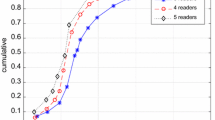Abstract
With the increase in demand for indoor positioning accuracy, the traditional LANDMARC algorithm introduces numerous tags leading to interferences between them. To address this issue and reduce costs, a new RFID indoor positioning algorithm was proposed. This novel approach was based on the integration of the Kalman filter and LANDMARC algorithm, along with the introduction of virtual tags. The primary aim of this algorithm was to reduce deployment cost and positioning errors while achieving more precise tag motion and position change descriptions. Moreover, this algorithm utilized the signal strength model of LANDMARC and the estimation results of the Kalman filter to infer and correct the target position with nuance. Simulation experiments show that the algorithm produces reliable results with high positioning accuracy, robustness, and adaptability.
Access this chapter
Tax calculation will be finalised at checkout
Purchases are for personal use only
Similar content being viewed by others
References
Zafari, F., Gkelias, A., Leung, K.K.: A survey of indoor localization systems and technologies. IEEE Commun. Surv. Tutor. 21(3), 2568–2599 (2019)
Dong, F., Shen, C., Zhang, J., et al.: A TOF and Kalman filtering joint algorithm for IEEE802. 15.4 a UWB Locating. In: 2016 IEEE Information Technology, Networking, Electronic and Automation Control Conference, pp. 948–951. IEEE (2016)
Wei, H., Wang, D.: Research on improved RFID indoor location algorithm based on LANDMARC. In: Proceedings of the 2022 4th International Conference on Robotics, Intelligent Control and Artificial Intelligence, pp. 1294–1297 (2022)
Ren, J., Bao, K., Zhang, G.: LANDMARC indoor positioning algorithm based on density-based spatial clustering of applications with noise–genetic algorithm–radial basis function neural network. Int. J. Distrib. Sens. Netw. SAGE Publications Sage UK: London, England 16(2), 1550147720907831 (2020)
Hu, B., Peng, H., Sun, Z.: LANDMARC localization algorithm based on weight optimization. Chin. J. Electron. 27(6), 1291–1296 (2018)
Li, L., Zheng, J., Luo, W.: RFID indoor positioning algorithm based on proximal policy optimization. Comput. Sci. 2021(48), 274–281 (2021)
Fazzinga, B., Flesca, S., Furfaro, F., et al.: Interpreting RFID tracking data for simultaneously moving objects: an offline sampling-based approach. Expert Syst. Appl. 152, 113368 (2020)
Li, X., Zhang, Y., Marsic, I., etal.: Deep learning for RFID-based activity recognition. In: Proceedings of the 14th ACM Conference on Embedded Network Sensor Systems CD-ROM, pp. 164–175 (2016)
Wu, X., Deng, F., Chen, Z.: RFID 3D-landmarc localization algorithm based on quantum particle swarm optimization. Electronics 7(2), 19 (2018). Tan, P., Tsinakwadi, T.H., Xu, Z., et al.: Sing-ant: RFID indoor positioning system using single antenna with multiple beams based on LANDMARC Algorithm. Appl. Sci. 12(13), 6751 (2022)
Liu, X., Wen, M., Qin, G., et al.: LANDMARC with improved k-nearest algorithm for RFID location system. In: 2016 2nd IEEE International Conference on Computer and Communications (ICCC), pp. 2569–2572. IEEE (2016)
Zhou, J., Shi, J.: A comprehensive multi-factor analysis on RFID localization capability. Adv. Eng. Inform. 25(1), 32–40 (2011)
Li, H., Chan, G., Wong, J.K.W., et al.: Real-time locating systems applications in construction. Autom. Constr. 63, 37–47 (2016)
Jiang, T., Huang, Y., Wang, Y.: Study on improved LANDMARC node localization algorithm. In: Xie, A., Huang, X. (eds.) Advances in Electrical Engineering and Automation. AISC, vol. 139, pp. 415–421. Springer, Heidelberg (2012). https://doi.org/10.1007/978-3-642-27951-5_62
Li, J., Wu, Z., Wu, C., et al.: An inexact dual fast gradient-projection method for separable convex optimization with linear coupled constraints. J. Optim. Theory Appl. 168, 153–171 (2016)
Omer, M., Tian, G.Y.: Indoor distance estimation for passive UHF RFID tag based on RSSI and RCS. Measurement 127, 425–430 (2018)
Chai, J., Wu, C., Zhao, C., et al.: Reference tag supported RFID tracking using robust support vector regression and Kalman filter. Adv. Eng. Inform. 32, 1–10 (2017)
Wu, X., Deng, F., Chen, Z.: Rfid 3D-landmarc localization algorithm based on quantum particle swarm optimization. Electronics 7(2), 19 (2018)
Xu, H., Wu, M., Li, P., et al.: An RFID indoor positioning algorithm based on support vector regression. Sensors 18(5), 1504 (2018)
Zhu, J., Xu, H.: Review of RFID-based indoor positioning technology. In: Barolli, L., Xhafa, F., Javaid, N., Enokido, T. (eds.) IMIS 2018. AISC, vol. 773, pp. 632–641. Springer, Cham (2019). https://doi.org/10.1007/978-3-319-93554-6_62
Shirehjini, A.A.N., Shirmohammadi, S.: Improving accuracy and robustness in HF-RFID-based indoor positioning with Kalman filtering and Tukey smoothing. IEEE Trans. Instrum. Meas. 69(11), 9190–9202 (2020)
Li, N., Ma, H., Yang, C.: Interval Kalman filter based RFID indoor positioning. In: 2016 Chinese Control and Decision Conference (CCDC), pp. 6958–6963. IEEE (2016)
Xu, H., Ding, Y., Li, P., et al.: An RFID indoor positioning algorithm based on Bayesian probability and K-nearest neighbor. Sensors 17(8), 1806 (2017)
Zeng, Y., Chen, X., Li, R., et al.: UHF RFID indoor positioning system with phase interference model based on double tag array. IEEE Access 7, 76768–76778 (2019)
Wang, C., Shi, Z., Wu, F., et al.: An RFID indoor positioning system by using particle swarm optimization-based artificial neural network. In: 2016 International Conference on Audio, Language and Image Processing (ICALIP), pp. 738–742. IEEE (2016)
Author information
Authors and Affiliations
Corresponding author
Editor information
Editors and Affiliations
Rights and permissions
Copyright information
© 2024 ICST Institute for Computer Sciences, Social Informatics and Telecommunications Engineering
About this paper
Cite this paper
Jiangbo, W., Wenjun, L., Hong, L. (2024). Research on RFID Indoor Localization Algorithm Based on Virtual Tags and Fusion of LANDMARC and Kalman Filter. In: Li, J., Zhang, B., Ying, Y. (eds) 6GN for Future Wireless Networks. 6GN 2023. Lecture Notes of the Institute for Computer Sciences, Social Informatics and Telecommunications Engineering, vol 554. Springer, Cham. https://doi.org/10.1007/978-3-031-53404-1_20
Download citation
DOI: https://doi.org/10.1007/978-3-031-53404-1_20
Published:
Publisher Name: Springer, Cham
Print ISBN: 978-3-031-53403-4
Online ISBN: 978-3-031-53404-1
eBook Packages: Computer ScienceComputer Science (R0)




